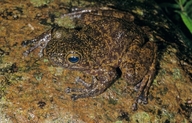|
Boehmantis microtympanum (Angel, 1935)
| family: Mantellidae subfamily: Mantellinae genus: Boehmantis |
 © 2008 Miguel Vences and Frank Glaw (1 of 2) |
|
|
|
Description Similar species: This large species can easily be mistaken with Mantidactylus grandidieri and M. guttulatus which, however, have less expanded discs on fingers and toes. Smaller specimens can also be mistaken with Spinomantis microtis which occurs in south-eastern Madagascar as well but appears to be confined to higher elevations. Juveniles may also be confused with Mantidactylus lugubris and related species which can occur syntopically. Distribution and Habitat Country distribution from AmphibiaWeb's database: Madagascar
Life History, Abundance, Activity, and Special Behaviors Breeding takes place in fast-flowing, rocky streams (Nussbaum et al. 2008). Trends and Threats Possible reasons for amphibian decline General habitat alteration and loss Comments
References
Glaw, F., and Vences, M. (2007). Field Guide to the Amphibians and Reptiles of Madagascar. Third Edition. Vences and Glaw Verlag, Köln. Nussbaum, R., Raxworthy, C., and Andreone, F. (2008). Boehmantis microtympanum. In: IUCN 2008. 2008 IUCN Red List of Threatened Species. www.iucnredlist.org. Downloaded on 22 April 2009. Originally submitted by: Miguel Vences and Frank Glaw (first posted 2000-12-13) Edited by: Henry Zhu (2010-07-19) Species Account Citation: AmphibiaWeb 2010 Boehmantis microtympanum <https://amphibiaweb.org/species/4615> University of California, Berkeley, CA, USA. Accessed May 20, 2025.
Feedback or comments about this page.
Citation: AmphibiaWeb. 2025. <https://amphibiaweb.org> University of California, Berkeley, CA, USA. Accessed 20 May 2025. AmphibiaWeb's policy on data use. |



 Map of Life
Map of Life